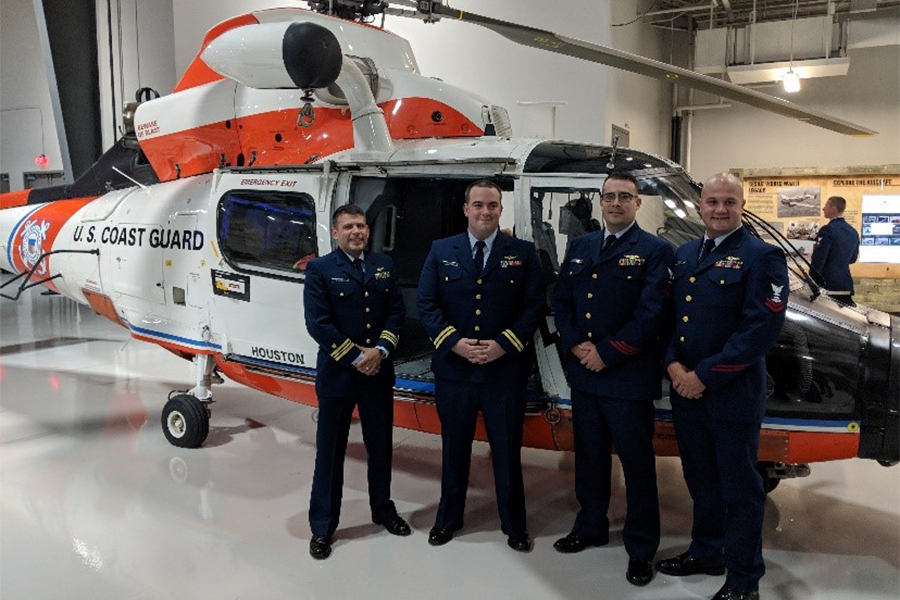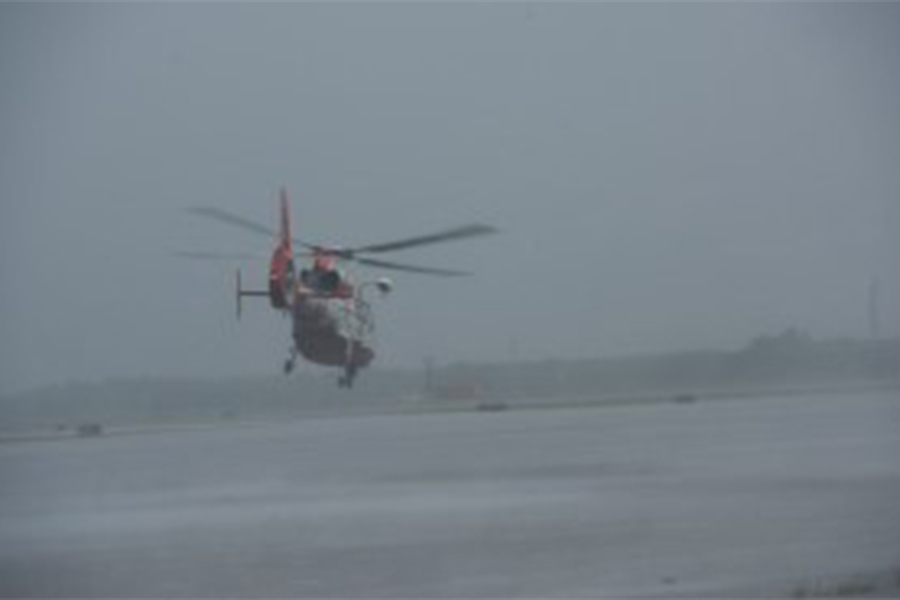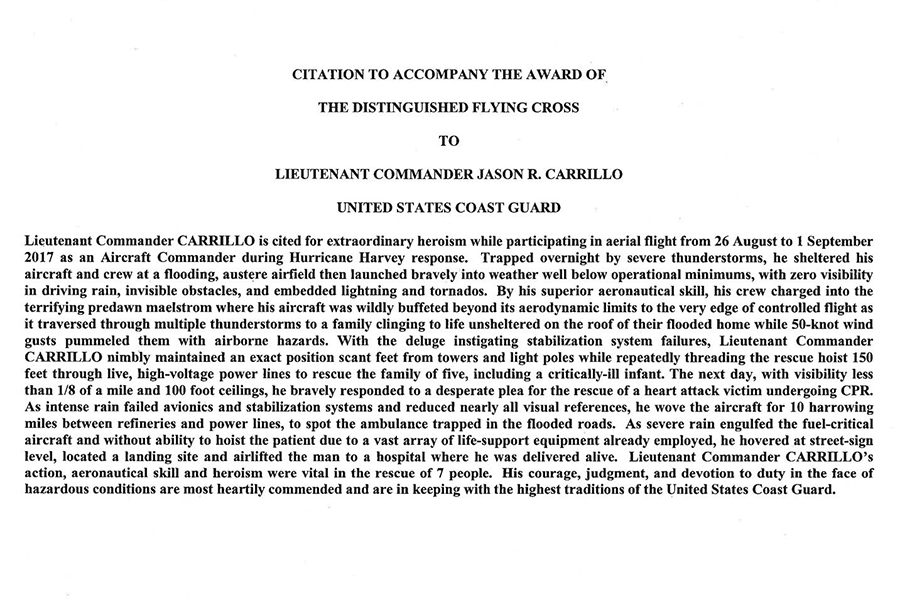AAE graduate student, Coast Guard helicopter pilot awarded Distinguished Flying Cross

J.R. Carrillo could not see.
Even with night vision goggles on.
It wasn’t just the driving rain surging in through the top of the MH-65D Dolphin helicopter. It wasn’t just dark clouds so dense they may as well have been walls. It wasn’t just the raging wind, blowing debris.
Every element during the early stages of Hurricane Harvey in 2017 combined for a perfect storm of lack of visibility.
Lightning offered accompaniment to the gusting winds and downpour but no sustained light, making the idea of taking off from Bay City Regional Airport in southeast Texas seem impossible.
Carrillo, a Lieutenant Commander in the Coast Guard, and his crew were there because they couldn’t make it back to Coast Guard Air Station in Houston the night before — when they’d launched on another Search and Rescue case — so they sought shelter in a corrugated, WWII-era hangar, waiting for a respite from the storm.
But they couldn’t keep waiting.
At about 4 a.m. on August 26, Carrillo got a call from his operations officer. Carrillo’s crew was “one of the only game in town” at that point, early in the storm, he was told. Other aircrews could not get to the base to launch because of flooding, and hundreds of distress calls already were inundating the sector command center. So Carrillo looked at a crew that included Lt. Brian Muldoon (co-pilot), Aviation Maintenance Technician First Class Travis Hebrank (flight mechanic) and Aviation Survival Technician Second Class Vince Neiman (rescue swimmer).
“All right, guys, we’re already here. This is what we get paid to do,” Carrillo told them. “All of us are going to fly this aircraft together.
“This is what we’re going to tell our grandkids about.”
Carrillo knew the risks. Though the MH-65 is an advanced rescue helicopter with a full spectrum of advanced sensors, Search and Rescue ultimately depends on being able to see. While trying to navigate visually at a low altitude, he and his crew risked inadvertently driving into the clouds and colliding with power lines and towers, and the storm’s downdrafts could smash the aircraft into the ground before they had time to react. Flying higher would allow the instruments to guarantee obstacle clearance, but Carrillo would have to head deeper into the storm, and the wind gusts and turbulence likely would tear the fragile helicopter apart.
But if Carrillo and his crew didn’t get off the ground, what would happen to all the Texans who needed help? The women in labor, ones in need of dialysis, people whose life support equipment was dying? The ones ambulances couldn’t reach because of the flooded roads?
The crew lit the engines and took off with limited visibility. When they reached only 50 feet, they were forced back down onto the now-flooding airport by low clouds and driving rain. Carrillo realized the only option was to risk flying blind, using only instruments, with the crew’s help. He attempted flight again, and Carrillo fought the most wicked turbulence he’d ever experienced, getting thrown around as the aircraft jostled.
“It was the scariest 10 minutes of my life,” he said. “I never, ever want to do that again in my entire life. But we made it. We came out the other side.”
Over the next five hours, Carrillo and his crew kept achieving the improbable, in a storm that was deluging Texas, burying homes and schools and businesses in water, forcing people to climb onto rooftops to avoid being submerged. Other buildings were simply decimated. Devastation was everywhere.
Carrillo called it “mass chaos.”
He and his crew performed Urban Search and Rescue, a dangerous mission area that’s almost impossible to practice. Dodging light poles on interstates, weaving between buildings and performing hoists from altitudes as high as 150 feet to avoid power lines coursing through flooded neighborhoods, Carrillo led his crew into neighborhoods to identify and rescue the most critical victims. When the aircraft was full, Carrillo would return to Ellington Field in Houston to drop off survivors, refuel and launch again.
One could argue this kind of event is exactly what Carrillo could have expected when he joined the Coast Guard after 10 years of service in the Navy: The Coast Guard motto of “always ready” applies, in part, to protecting the personal safety and security of people in the United States. But the Coast Guard also has a saying among its helicopter pilots that almost plays like a warning, cautioning that 99 percent of the time doing something crazy in a helicopter is grounds for trouble. One percent of the time, it leads to heroics.

If he wasn’t already for his 20 years of military service, Carrillo became a hero over that five-day span, like so many of his brethren in the Coast Guard. The Coast Guard reported it rescued 11,022 people during Hurricane Harvey, more than it had for the entire previous year.
On Friday, Carrillo was rewarded for the role he played in the largest Coast Guard aviation response to a natural disaster since Hurricane Katrina in 2005: He was awarded the Distinguished Flying Cross during a ceremony at Coast Guard Headquarters in Washington D.C. The medal, presented by Admiral Charles Ray, was given for Carrillo’s “extraordinary heroism while participating in aerial flight … as an aircraft commander during Hurricane Harvey response,” the citation that accompanied the award read.
“Lieutenant Command Carrillo’s action, aeronautical skills and heroism were vital in the rescue of seven people,” the citation read. “His courage, judgment, and devotion to duty in the face of hazardous conditions are most heartily commended and are in keeping with the highest traditions of the United States Coast Guard.”
The Distinguished Flying Cross has been bestowed on some of the country’s most iconic pilots, including Charles Lindbergh, Amelia Earhart, George H.W. Bush, Chuck Yeager and a who’s who of astronauts, including Purdue alumni Guy Gardner, Eugene Cernan and Gus Grissom.
“It’s what we all aspire to as military pilots. It’s like, ‘I want to be that guy.’ This is what you hear about in the movies. Never in a million years did I figure I would be that position to do that,” said Carrillo, whose interest in flying was piqued as a kid watching planes near Pearl Harbor while his father was stationed at Hickam Air Force Base in Hawaii.
“Never did I think I did anything that fantastic. Somebody somewhere thinks I did. I am humbled and very honored. I was the only one on the crew who was selected for this particular award, but we were a team. Flying out of that airport, sure, I was the guy physically controlling the helicopter, but we’re all working together as a team to do this. So, to me, it’s not me. It’s about the crews. It’s about everybody who was there.”
In a bit of a twist, Carrillo had to inform a college professor about the ceremony: Carrillo missed class to attend it.
Carrillo currently is a master’s student in the School of Aeronautics and Astronautics, focusing on structures and materials, an area of research that will serve him well in his role as aeronautical engineering officer. But before leaving campus for D.C. last week, Carrillo had to offer a heads-up to Tyler Tallman, an assistant professor in AAE who also is Carrillo’s advisor. Tallman certainly had no issues with Carrillo’s absence.
Especially with the more he heard about Carrillo’s actions in August 2017, when Harvey dumped more than 50 inches of rain on Houston, the weight of which sank the city temporarily by nearly an inch.
“It was just five days of craziness,” Carrillo said. “Everyone was flying in some crazy stuff.”

Other than the miracle takeoff, Carrillo had plenty of other dramatic flying feats during the Category 4 hurricane. One specifically still stands out.
On Day 2 of the storm, Carrillo’s crew included Hebrank again along with Lt. Pete Schofield (co-pilot) and Aviation Survival Technician Second Class Chris Wilson (rescue swimmer) from the Air Station in Corpus Christi, which had been hit by Harvey just days before. They flew to North Houston to check on a woman who’d called for help the previous day and then picked up a woman with appendicitis and flew her to the hospital. After a stop to get refueled, they were given the assignment to pick up a man in his 80s who’d had a heart attack. Paramedics were first responders, but they weren’t able to get him to the hospital because roads were flooded. CPR was in progress.
The crew got an address, but with the Coast Guard’s sector command center communication lines severed due to the flooding, that address didn’t help much: Navigation systems on aircraft deal with latitudes and longitudes, so they have no way of converting that into an address. Carrillo and his crew had to use a cell phone to find the location — and the pick-up was surrounded by industrial refineries and live power lines. Carrillo was weaving in and out of the tattered environment, only 100 feet off the ground, in “the worst weather I’ve ever flown in visually.”
“It was like a video game,” he said.
Eventually, the crew connected with the ambulance. But the man wasn’t only getting CPR — he was on a CPR machine, which meant Carrillo’s crew couldn’t simply hoist him into the helicopter. And they couldn’t disconnect him from the machine, for fear of the man dying. They had to find a place to land. After hovering over cars, slipping between power lines and just over stop signs, they finally found a baseball field with a parking lot that wasn’t submerged. They landed in the lot, kicked Wilson out to make room for a paramedic, the man and the machine, and headed to a hospital.
Not that the trip there was easy either.
Visibility still was minimal, and by then, the Department of Defense had sent other military helicopters in. There were as many as 300 being deployed to the area. But where?

“Air Traffic Control could tell you, ‘There’s one over there,’ but I can’t see him because he’s behind the clouds. I don’t know how many near mid-air collisions we had that day, sneaking to the hospital,” Carrillo said.
But the crew — and the patient — arrived safely. After that medevac, Carrillo headed back to get the aircraft fueled up again. And, finally, rest. He’d reached the Coast Guard’s “endurance limit,” and waves of help had begun arriving from all units across the country.
The respite didn’t last long, though.
Carrillo’s normally assigned duties as an engineering officer who ensures airworthiness of the unit’s helicopters, with the help of a handful of technicians, increased considerably. More than 400 maintenance personnel and 30 aircraft were brought in for the around-the-clock rescue effort — and the maintenance personnel were “heroes in their own right,” Carrillo said.
The intense rain literally peeled paint off the aircraft, seeped around sealants and gaskets and shorted out vital avionics and communications equipment, leaving crews unable to talk to each other in flight. Ground handling crews worked 12-hour shifts in ankle-deep water to furiously refuel and turn aircraft around to go back out. Helicopters were flown to neighboring Air Stations in New Orleans and Mobile, Ala., where “tiger teams” would descend on them and complete overhauls in record time to get them back into the fight.
“It was truly an all-hands effort by the entire service,” Carrillo said. “Yet the focus on safety was still so rigorously adhered to that not a single maintenance mishap occurred.”
Once the storm subsided, Carrillo heard stories of the incredible work others had done. There are countless stories of heroism, he knows.
He was just happy he could rise to the occasion and perform when needed most.
“It’s kind of like my Super Bowl ring. I went to the big game, and we did well,” Carrillo said. “It’s just traumatic the first couple days. You know what you’ve been trained to do. We do simulators every year. But the simulator is a video game, so if you want to do this for practice, fine. You get the red screen of death? Reset it and do it again. Make it work. You learn all these skills, but the assumption is, ‘I will never have to do this. This is crazy talk. I wouldn’t need to do that in real life.’ Well, real life happened. And we did it. And it worked. So, to me, that’s always been the cool part. To go out there and say, ‘Well, guys, this is supposed to work and it’s going to work, and this is what we’re going to tell our grandkids about.’ For it to work, I think really is a neat thing.
“Then to see the aftermath, to start reading the statistics, saving more people in a five-day period than all of the Coast Guard aviation had the previous year. That, to me, really solidified the scale of what was going on. What we did was very worthwhile, but it was a piece of a much, much bigger puzzle.”

